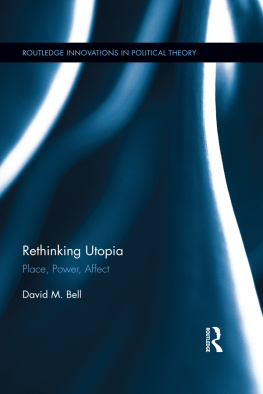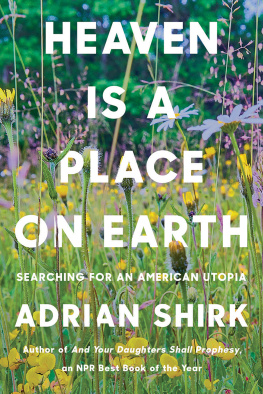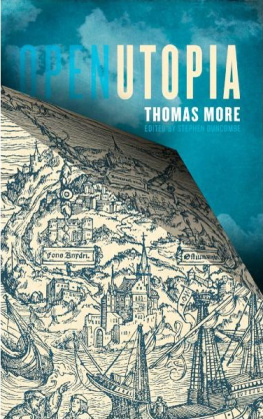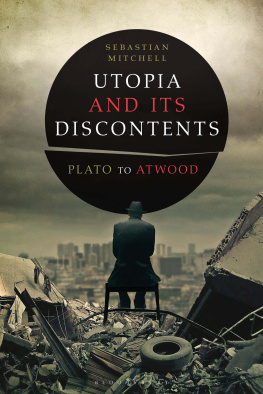2015 by the University of Washington Press
Printed and bound in the United States of America
Design by Thomas Eykemans
Composed in Minion, typeface designed by Robert Slimbach
19 18 17 16 15 5 4 3 2 1
All rights reserved. No part of this publication may be reproduced or transmitted in any form or by any means, electronic or mechanical, including photocopy, recording, or any information storage or retrieval system, without permission in writing from the publisher.
UNIVERSITY OF WASHINGTON PRESS
www.washington.edu/uwpress
LIBRARY OF CONGRESS CATALOGING-IN-PUBLICATION DATA
Srinivas, Smriti.
A place for utopia : urban designs from South Asia / Smriti Srinivas.
pages cm. (Global South Asia)
Includes bibliographical references and index.
ISBN 978-0-295-99498-7 (hardcover : alk. paper)
1. City planningSouth Asia. 2. Cities and townsSouth Asia. I. Title.
HT169.S63S75 2015 307.12160954dc23 2015006089
The paper used in this publication is acid-free and meets the minimum requirements of American National Standard for Information SciencesPermanence of Paper for Printed Library Materials, ANSI Z39.481984.
ACKNOWLEDGMENTS
AS the raw materials, field visits, and insights that have informed this book since 2008 came to acquire more coherent form, many read and critiqued my efforts or offered support and information in other ways. I thank especially Joe Alter, Veena Das, Ram Guha, Lindsay Jones, Jeff Kripal, Joanne Waghorne, and Volker Welter. My thanks also to Sister Saradeshaprana, Brahmachari Jnana Chaitanya, Gordon Stavig, and Darshann at the Vedanta Society of Southern California; to the University of Strathclyde Library, Department of Archives and Special Collections, and especially Rachel Pike and Carol Stewart; and to the staff, librarians, and gardeners at the Theosophical Societyall for their timely assistance and other kindnesses. I have benefitted much from the thoughtful comments of Mary Hancock, AbdouMaliq Simone, and an anonymous reader, all of whom read an earlier draft of this manuscript. My thanks also to the University of Washington Press executive editor, Lorri Hagman, and the series editors of Global South Asia, for their confidence in this project, and to Puja Boyd, Julie Van Pelt, Mary Ribesky, Scott Smiley, and Tim Zimmermann for their professionalism and competence. My South Asian publishers, Orient Blackswan, and Veenu Luthria, Krishnadev Rao, and Nandini Rao have my deep thanks for making available yet another book of mine in the region; our intellectual association has now lasted more than a decade.
I was invited by several scholars and institutions to present my work in progress, and the discussions at these events have enriched my thinking and generated fresh writing. My thanks to Joanne Waghorne for inviting me to present a paper at the stimulating Mellon symposium Place/No Place: Spatial Aspects of Urban Asian Religiosity, Syracuse University, in 2009; to Srilata Raman and Christoph Emmrich for their generous hospitality and the 2009 invitation to the Hindu Studies Colloquium, University of Toronto; and to Suzana Sawyer for insisting I present my research to my own anthropology colleagues and students in 2010. I also thank Lindsay Jones for the wonderful arrangements for Maitreyi and the invitation to give the Fourth At-Large Lecture of the Ohio State University Center for the Study of Religion in 2012; the Berlin organizers of Global Prayers for asking me to give a plenary talk in Mumbai in 2012; Carol Upadhya and Narendar Pani for inviting me to present at The City in Question lecture series in 2012, National Institute for Advanced Studies, Bangalore; and Thomas Hansen and Sharika Thiranagama for the invitation to the Stanford University Fourth Urban South Asia Seminar, Vernacular Urbanism, in 2013 (and for so kindly taking care of my daughter). Most recently, my thanks are due to Mahesh Rangarajan for the superb discussion of my talk at the Cities in History series in 2014, Nehru Memorial Museum and Library, Delhi; to the Indian Institute for Human Settlements and Shubha Chacko for organizing my 2014 public lecture in Bangalore; and to Rahul Mehrotra for the 2014 invitation to present my work at the Harvard University South Asia Institute Urbanization seminar.
Additional venues for presentations included panels at the Annual South Asia Conference, University of Wisconsin, Madison, in 2009; the 2011 American Academy of Religion annual meeting; and the 2012 American Anthropological Association annual conference. I am grateful to Leslie Orr, Eliza Kent, and Mary Hancock for organizing these occasions. My special thanks to the students who participated (sometimes more than once) in graduate seminars that I directed at the Department of Anthropology, University of California, Davis, between 2010 and 2013, where together we explored ideas of utopias and place-making from a number of disciplines.
I acknowledge the substantial grant support from the University of California, Davis, for this project over the past six years: I was awarded a New Research Initiatives and Collaborative Interdisciplinary Research Grant (20112012) that helped me make deep inroads into the research for this book. I was assisted by Small Grants in Aid of Research practically every year (2008, 2009, 2012, 2013, and 2014), which supported my field visits to India; other annual travel awards made conference presentations possible. The intellectual and friendly fellowship provided by the University of California Multicampus Research Group Award (20132015) for Urban Place-Making and Religiosity and the Multicampus Working Group Award (20122013) for Spaces for the Future: Religion in Urban Place-Making has been a wonderful treat.
This book is leavened by the memories of convivial moments and ideas shared in many cities across the globe: with Ana Arroio, Vinay Baindur, Thomas Bender, Goh Benglan, Andre Beteille, Partha Bora, Christina Carr, Sangeeta Chattoo, Dashiell, Farha Ghannam, Mary Hancock, Peter Heitzman and Karen Savoca, Mark Heitzman and Deb, Suad Joseph, Lata Mani, Balan Nambiar, Bettina Ngweno, V. N. Pandit and Krishna Pandit, Vaidehi Ramanathan, Al Roberts and Polly Roberts, Supriya Roychoudhari, Simon Sadler, Nirupama Sarma, Savyasaachi, Anuradha Shah, Nirupa and Garry Shephard, Asiya Siddiqi, Anand Swamy, Khalid Tyabji, Kalpana Viswanath, and Punam Zutshi. Sridhar Rajaram has my gratitude for reading the stars and Donna Hirschfield for offering steady counsel.
My book was conceived and written in India and California and is, in many ways, a collective endeavor. I was supported by enduring friendships and extended conversations with Shubha Chacko, V. Geetha, May Joseph, and Srilata Raman, all of whom offered many insights that enriched this book. I continue to be inspired by the strength and creativity of my sister, Smita Srinivas. My parents Nirmala and S. N. S. Murthys love and wisdom, Jeff Bartaks steadfast companionship and support, and the gift of Maitreyi in my life have sustained me. Together, they made possible my passage through a period of unimagined crisis, loss, and change to a place of some understanding.










